Galaxies Near and Far
Spiral, elliptical, irregular, barred spirals, dwarf galaxies, and quasars are easy to learn, because their names describe them.
Spiral Galaxies
We know what it's like to be inside a spiral galaxy, because we live in one, the Milky Way galaxy. The Sun lies near the small Orion Arm or "Spur", and between the Satittarius and Perseus Arms. Spiral arms of our galaxy are named for the constellations toward which we look to see them. The Milky Way has a small central bar so it is actually a SBbc barred spiral.
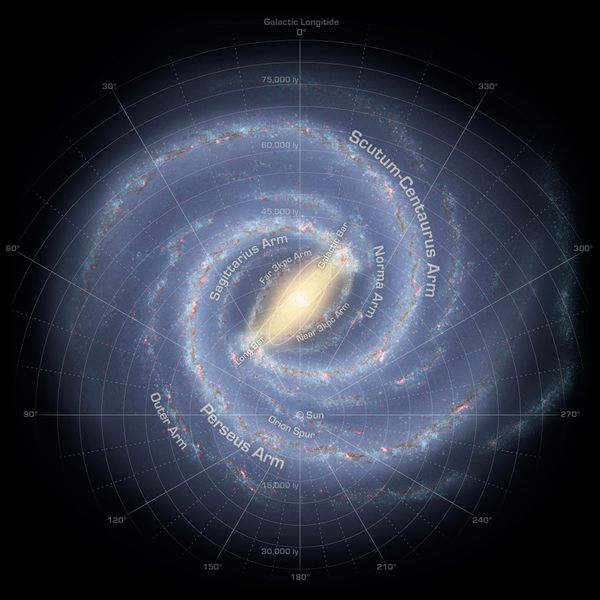
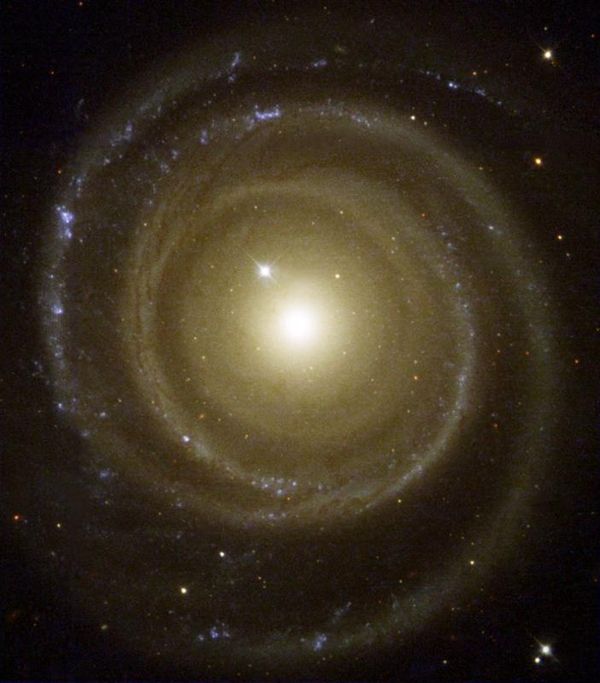
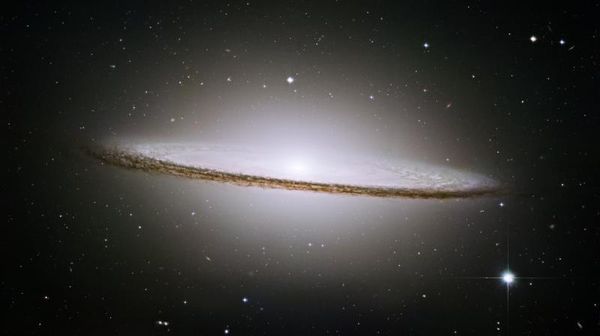
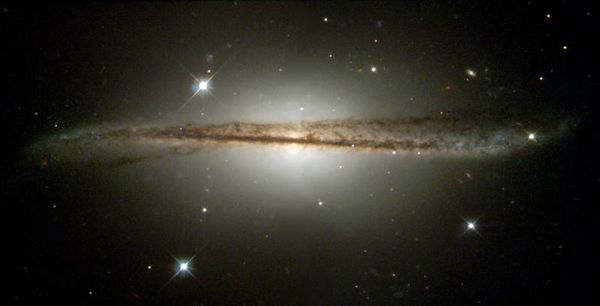
A spiral galaxy has a flattened disk of stars but also a spherical glowing halo. The stars in the disk are young, typically recently formed, and are different from those in the halo. Halo stars are small, as much as 13 billion years old, made early in the galaxy's history, early in the history of the Universe! They are so old that they are metal-poor, having been made before other larger stars exploded and sent metals out into the galaxy.
You can see that the halo in these images looks yellow or even slightly red compared to the bluer disk. Blue stars are more massive, and age quickly. Only the less massive red stars remain in the aging halo population. The presence of obscuring dust, dark molecular clouds, and bright emission nebulae is characteristic of regions of the galaxy were stars are being formed now.
Our Milky Way, the Andromeda Galaxy (M31), and Triangulum (M33) are the only spiral galaxies in the Local Group of Galaxies.

We needn't worry that the Sun will live only another 5 billion years, because the Andromeda Galaxy, which has a blue shift meaning it is approaching rather than receding, may collide with the Milky Way in 3 billion years. To see a simulation of what may happen see http://www.galaxydynamics.org or YouTube.
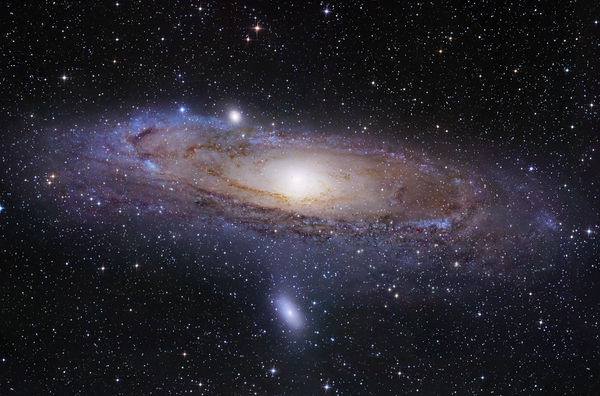
In their centers are black holes, a billion times as massive as normal black holes. These black holes are quiet now, having gobbled up nearby matter long ago. We can tell they are present because their gravity determines the orbits of stars close to the center.
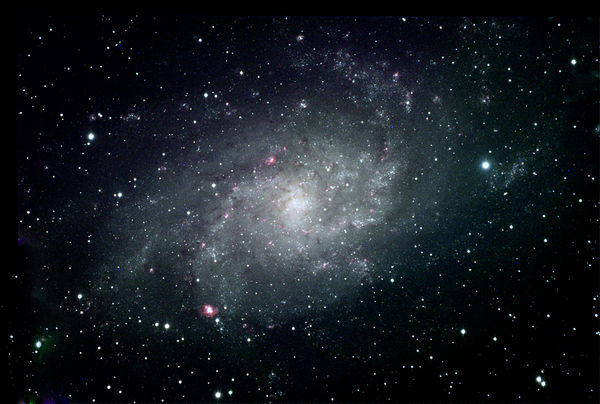
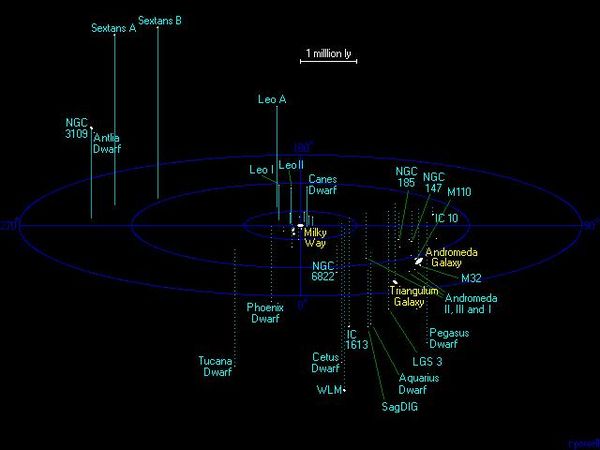
In their centers there are a supermassive black hole, millions of times as massive as a normal "stellar" black hole.
Elliptical Galaxies
Elliptical galaxies are plump elliptical clouds of stars, usually made of very old stars, and lacking the young hot blue stars they appear reddish. Typically an elliptical galaxy also has little dust, unless it is clearly the result of the collision of two or more galaxies such as this one.
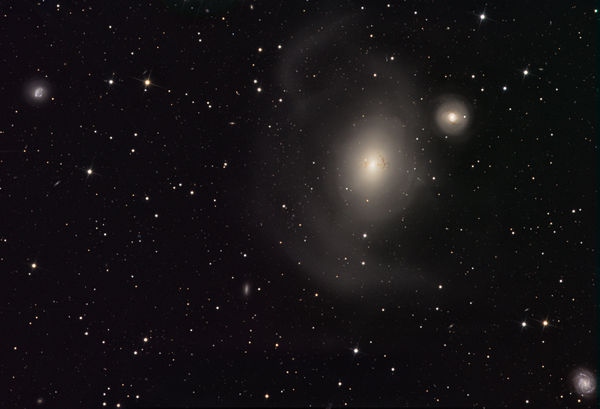
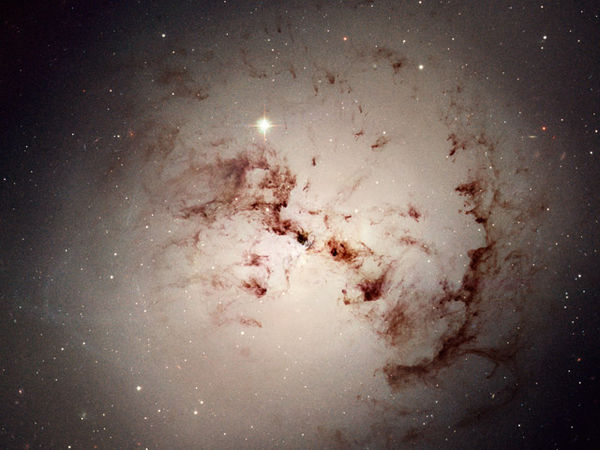
Elliptical galaxies are classified, roundest to most oblong, as E0, E2, E3, E4, E5, E6, E7. Elliptical galaxies really are ellipsoids, somewhat football-shaped, and quite unlike the flat disks of spiral galaxies that, seen at an angle, also may appear elliptical.
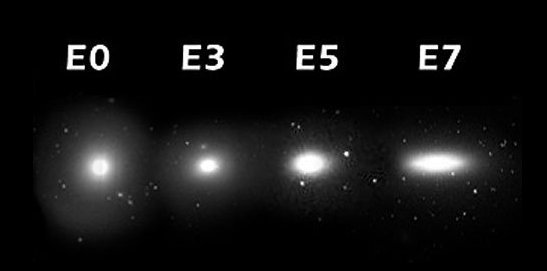
Some giant ellipticals are so huge they can swallow up giant spiral galaxies, like our Milky Way, in fact that is how they got that way! In the Virgo Cluster, for example, M84 and M87 are much bigger than the other galaxies of the cluster. Both have grown by gobbling up other galaxies, and both have active supermassive black holes in their centers with jets of electrons shooting out at speeds near the speed of light. The centers of giant elliptical galaxies seem to contain black holes. In many cases we can detect them by measuring the speeds of the stars in orbit close to the center. The black hole in M84 is nearly 2 billion times the mass of the Sun!
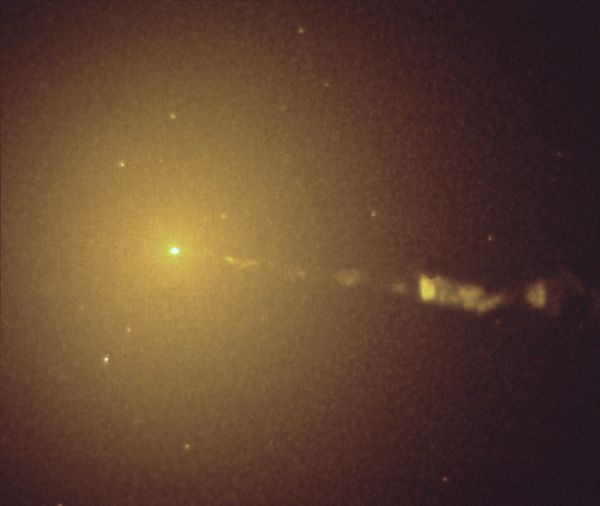
Barred Spiral Galaxies
The bars in some galaxies are more pronounced than that in our Milky Way, such as in NGC 1300, 70 million light years away (21 Mpc) in the constellation Eridanus. It is over 100,000 light years across, and is about the same size as the Milky Way. It is unusual in that while it is a classical barred spiral, it also has a spiral within the bar. Can you see it, near the center of this image of NGC 1300?
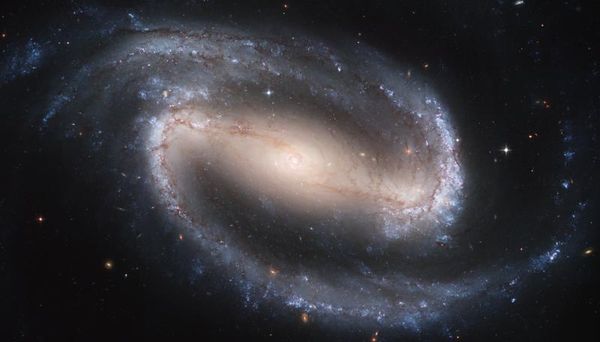
Dark filamentary "dust lanes" associated with star forming nebulae are common in spiral galaxies and are clearly seen in NGC1672, along with clusters of recently formed blue stars. This galaxy is 60 million light years (18 Mpc) away, and is about 75,000 light years across.
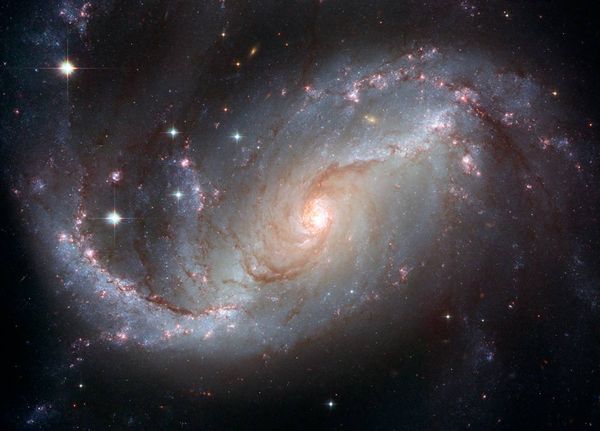
Edwin Hubble's Classifications of Elliptical, Spiral, and Barred Spiral Galaxies
Edwin Hubble did a simple classification to give a general idea of the infinite variety in galaxies. Round to long elliptical galaxies E0 to E7; least to most spiral spirals Sa to Sc; and least to most spiral barred spirals SBa to SBc. At the fork of the "Y" "S0" ellipticals, spirals, and barred spirals meet in a shape like a slightly flattened cigar.
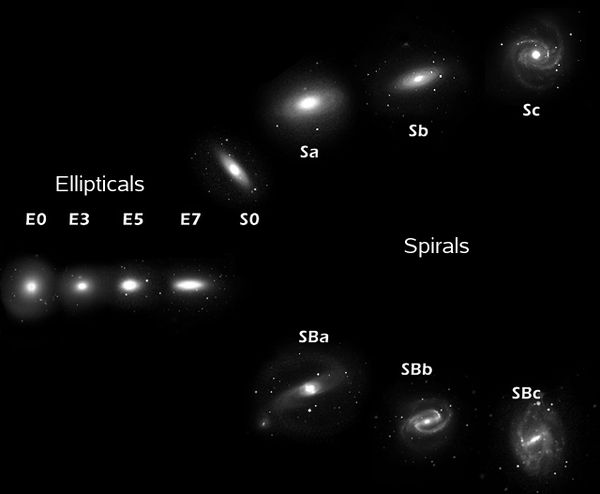
Irregular Galaxies
Irregular galaxies do not fit into the Hubble "tuning fork" and have no specific shape. Sometimes it is difficult to decide whether there is underlying structure. The Large and Small Magellanic Clouds, for example, are irregular in appearance but also have a bar that suggests they may be unusual small barred spirals.
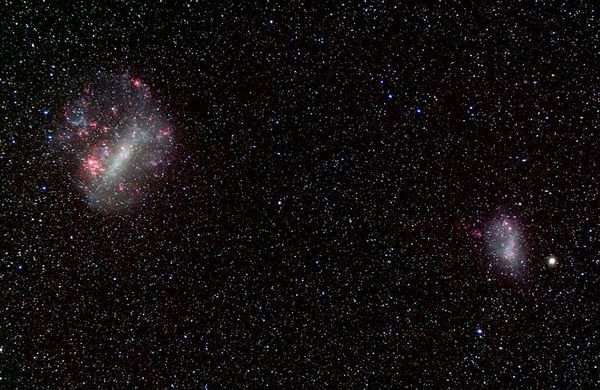
The small irregular galaxy NGC 1427A, seen in this image from the Hubble Space Telescope, is plunging into the Fornax cluster of galaxies at 600 km/s. Within the next billion years it will be completly disrupted by the impending collision.
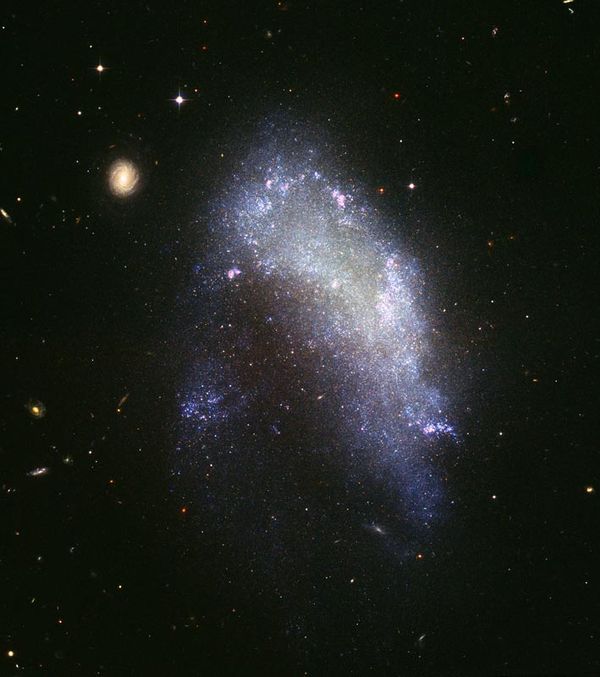
Sometimes Galaxies Collide
We see numerous colliding galaxies, such as the famous Whirlpool galaxy (M51a and M51b) seen below. Colliding galaxies spawn millions of new stars in glowing star-birth nebulae. Collisions such as these may explain how star formation is turned on in some galaxies.
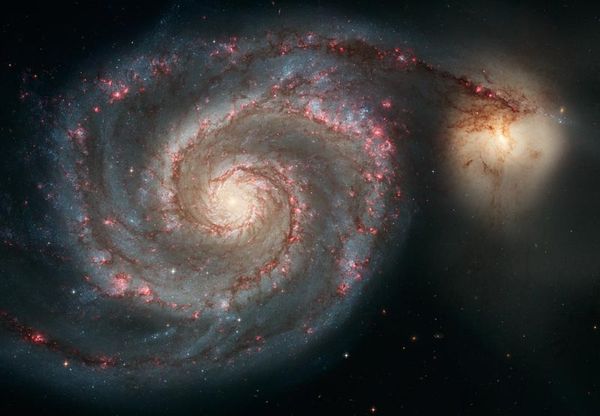
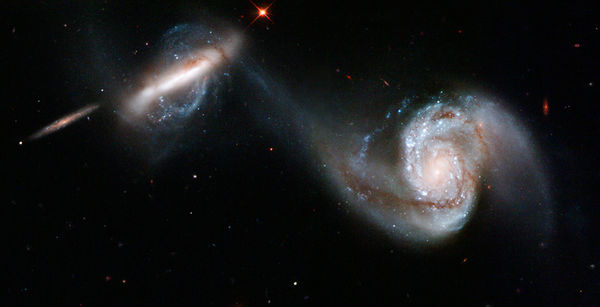
The Antennae galaxies were separate galaxies 1.2 billion years ago. Simulations of the collision predict that within 400 million years their nuclei will form a single core, and that the system will evolve into an elliptical galaxy.
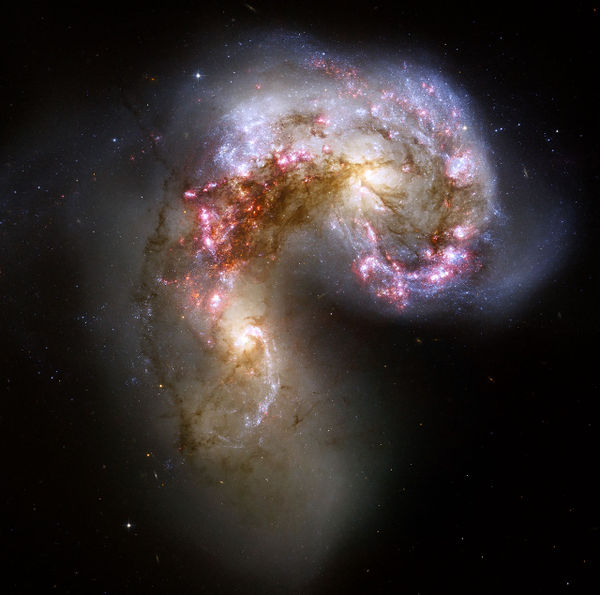
Sometimes the evidence of a collision is found by tracing the hydrogen gas between galaxies. Even in the well-studied Virgo Cluster, astronomers have just found tendrils 400,000 light years long connecting the elliptical galaxy M86 with the disturbed spiral galaxy NGC 4438.
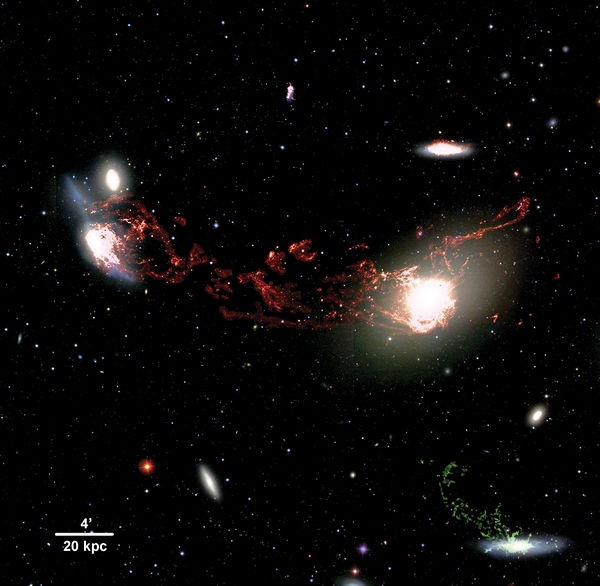
It seems frightening that our own Milky Way and the Andromeda galaxy may collide in 3 billion years, until we notice that, even as we speak, the Milky Way is already colliding with a small elliptical galaxy, Sagittarius Dwarf galaxy.
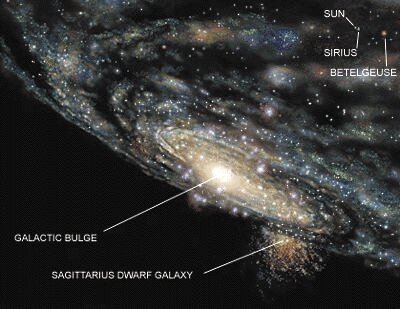
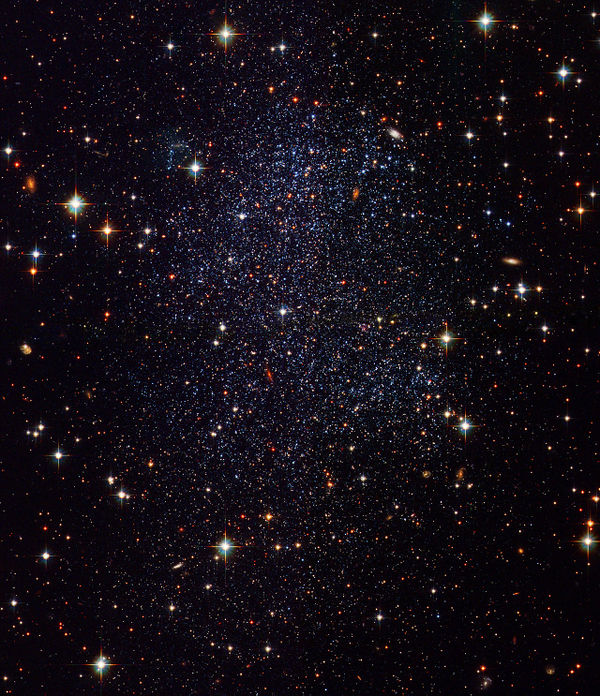
Quasars
Quasars were named "quasi-stellar" because they appeared as mysterious radio sources and bright points of light, star-like, but with unusual spectra. These points of light were extremely bright nuclei of galaxies fueled by supermassive black holes a billion times as massive as normal black holes! With better telescopes and cameras we may now see the fainter galaxies around these bright cores. Quasars are also called active galaxies because the black hole is still thrashing infalling matter into vortices that emit enormous amounts of energy and eject jets out thousands of light years into space.
Quasars are in the furthest reaches of the visible universe, created when the universe was compact and dense, the first throws of modern galaxies. They appear much like M87, only millions of times brighter at the central nucleus. Below we see a distant quasar, 10 billion light years (3 billion parsecs) away, through a cluster of galaxies "only" 7 billion light years away. The cluster's gravity acts as a lens, focusing the light from the bright yellow quasar and its super bright core into 4 bright blue-white star-like spots.
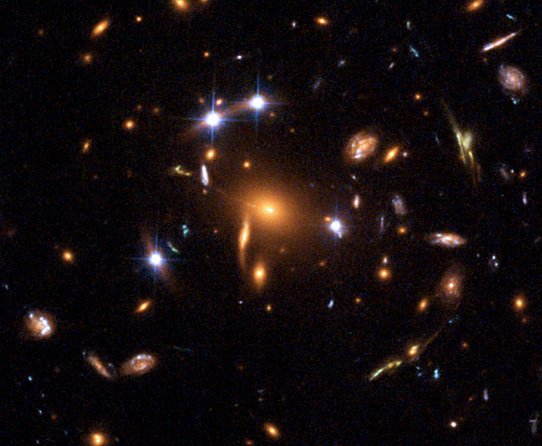
The Most Distant Galaxies
Billions of galaxies exist over 13 billion light years away. This means the light we see must have left those galaxies over 13 billion years ago, nearly to the beginning of time as we know it. The most distant galaxies we see are 13.2 billion light years distant, and there are only about 10 of those.


These images were assembled from hundreds of separated exposures with the Hubble Telescope pointing in one direction, creating a view to the visible horizon of the universe. There is an assortment of thousands of galaxies in at various stages of evolution in these images.
Distant galaxies are also being studied from the ground, in methodical surveys covering wider spans of the sky. The Digital Sky Survey has been accumulating images and spectra continuously since 2000, and provides a picture of the distribution and types of galaxies from those nearby out to a redshift of z=6 for the distant quasars. You can pariticipate in exploring and classifying the galaxies they are finding by joining the Galaxy Zoo project.
Galaxies Distributed Through the Universe Make a Pattern Like Swiss Cheese
Surveys of the universe have revealed a foamy pattern in the distribution of galaxies. There are large volumes of space that are mostly empty, and filaments of clusters of galaxies throughout. This short movie will take you on a journey out through the galaxies, based on the real data from the Sloan Survey.
We can simulate this too, by trying to understand how the universe got into its current state, and following the effect of the gravity to see clusters of galaxies developing in the early universe.
Where the Galaxies Stop
As we look further away, further back in time to within 900 million years of the Big Bang, these bright galaxies dwindle in number until there are none at all. Either none formed at that time, or none were bright enough for their light so be seen at so great a distance.
The First Stars Appeared Before There Were Galaxies ...
About 100 million years after the Big Bang when pressure and temperature were right for something to happen ... It will.
In the dense hot environment of the early universe, earliest stars were 100 to 1,000 solar masses, 4 to 14 solar radii, and 1 million to 30 million times more luminous than the Sun ! Stars were so massive, with so much gravity, that they burned out almost as soon as they were created, lasting no more than 30 million years, and exploding in supernovae like boundless displays of fireworks.
These giant stars and supernovae left behind all the elements on the periodic table. They also left behind ... black holes ... black holes of a size that could spawn the first small galaxies !!!
The first proto-galaxies formed around these black holes creating small quasars, active galaxies just 30 to 100 light years across, not much bigger than the Orion nebula, whereas today our Milky Way galaxy is 100,000 light years across.
... and Before the Stars the Dark Age
Which wasn't really dark at all
A "Dark Age", before there were stars, lasted a million years. Although there were no stars, it wasn't really dark at all. Energetic photons of light flew among the helium and hydrogen atoms, at wavelengths mostly in the visible and the near infrared, making the Universe glow red in all directions.
Meanwhile, little by little, slightly denser regions in the gas of newly formed hydrogen and helium atoms gradually drew together until they formed into super-giant, super-hot, blue stars. The Dark Age came to an end with the formation of these first stars.

At nearly 1000 K the universe at that time glowed with red and near infrared and light, the color and same temperature of an electric hotplate seen in a dark room.
Cosmic Background Radiation
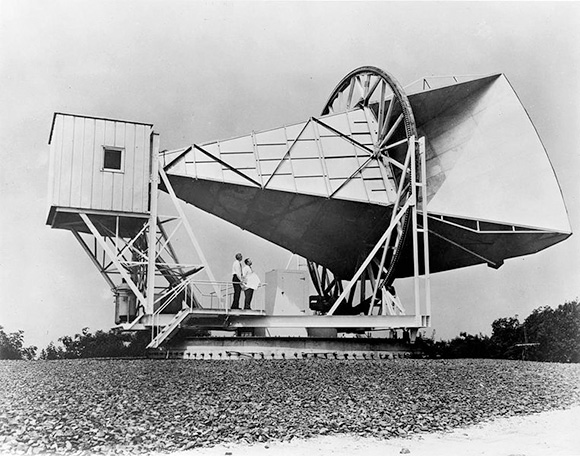
Cosmic Background Radiation was first thought to be noise and blamed it on two nesting pigeons in this Bell Horn Antenna
Before the Dark Age, the Universe was so hot that protons and neutrons could not hold onto electrons, so there were no atoms. Not until, 300,000 years after the Big Bang, the Universe and expanded and cooled to less than 3,000 K. These less energetic photons and weaker collisions among the particles allowed protons and neutrons to hold onto their electrons,. The first atoms of hydrogen and helium formed, and stayed intact.
Previously photons had been absorbed by the free electrons almost as soon as they had been emitted, like photons are caught inside stars taking thousands of years to get out. Now the Universe was cool enough to be transparent to photons, and they were suddenly set free to travel vast distances at the speed of light.
This sudden release of photons was the beginning of the Cosmic Background Radiation.
As the Universe expanded, the Cosmic Background light was carried with it. To us today, the Background "Radiation" appears red-shifted by z=1000 times, making the wavelengths appear 1000 times longer. Though emitted with wavelengths about 1,000 nm, in the near infrared at a temperature about 3000 K, the redshift makes the wavelengths of the photons much longer, "lazy", and less energetic. They now seem to be coming from a cold 3 K source (2.725 degrees above absolute zero), and they have shifted in wavelength so far, they are "microwaves" with wavelengths of about 1,000,000 nm (1 mm).
The Cosmic Background Radiation was accidentally discovered at the Bell Horn Antenna, where it was thought it might be noise caused by two nesting pigeons. If you want to watch something on your old analog television sets, you can always tune in the uh, educational Cosmic Background Radiation show, which appears as static on those channels being abandoned by the broadcast stations.
The Cosmic Microwave Background radiation is virtually the same in all directions, with only miniscule variations in apparent temperature. In the 1970's it was also found to be slightly "hotter" in one direction in space, a difference of about 0.1% of the apparent temperature. This was because it was slightly more red-shifted for viewing in one direction and blue-shifted for viewing in the opposite direction. This is the exact pattern that would be expected if our local group of galaxies were moving through the background radiation at a speed about 600 km/s! In a sense, we can tell which direction we are moving compared to the gas of hydrogen that made the first stars.
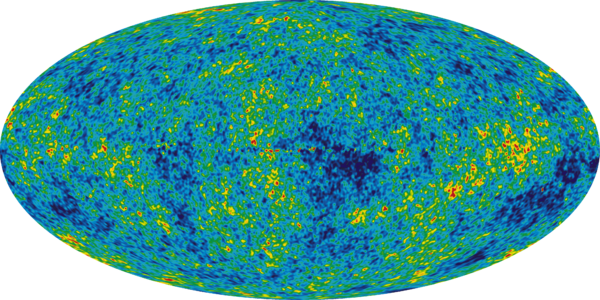
Cosmic Background Radiation that left on its path to us appearing to be from a 3000 K source, is seen today in the microwave wavelengths as if it came from a very cold 2.75K above absolute zero. This image shows the pattern of that light around the entire sky, with very tiny differences in apparent temperature mapped as a change in color.
Before the Cosmic Background Radiation
In the first 300,000 years of the Universe, temperatures cooled from 1027 K (that's 1,000,000,000,000,000,000,000,000,000 K, a trillion quadrillion Kelvin) down to 10,000 K.
With such extreme heat, photons in the form of ultraviolet light, x-rays and gamma rays made the universe extremely bright. It would have been like being inside of the star Sirius.
[[File:big_bang_evolution_of_universe.jpg|600px|center>
History of the Universe from the Big Bang
- to a super-bright super-hot expansion period
- to Cosmic background radiation
- to Stars
- to Galaxies with Stars with Planets
- to Life
The First 3 Minutes of the Universe
And as we've seen before, when temperatures and pressures are right for something to happen ... it will.
Out of the Big Bang came fantastically energetic photons of LIGHT, so energetic that they could disappear in a moment, and appear as matter. Just as Einstein found
E = mc2
m = E/c2
ENERGY became MATTER!
- The first 10-43 second is obscured by our lack of knowledge of how gravity works. By 10-32 seconds the universe had inflated enormously and the first particles appeared.
- By 10-5 seconds quarks linked up in trios to make protons.
- By 10-4 seconds the universe was left with 5x more protons than neutrons (protons being hydrogen nuclei).
- After one second the universe had expanded enough that it became transparent to neutrinos, and they went on their own way forever.
- After 3 minutes and 42 seconds, the universe had cooled enough for helium nuclei to be stable, and it had 25% of its ordinary matter in that form.
- After 1 year, its temperature was about that in the center of a star like the Sun, cooling gradually.
- After 300,000 years, light could get through it, to become the cosmic background we see today. The matter that remained began to coalesce under its own gravity, and the first stars appeared after a million years ... and eventually us.
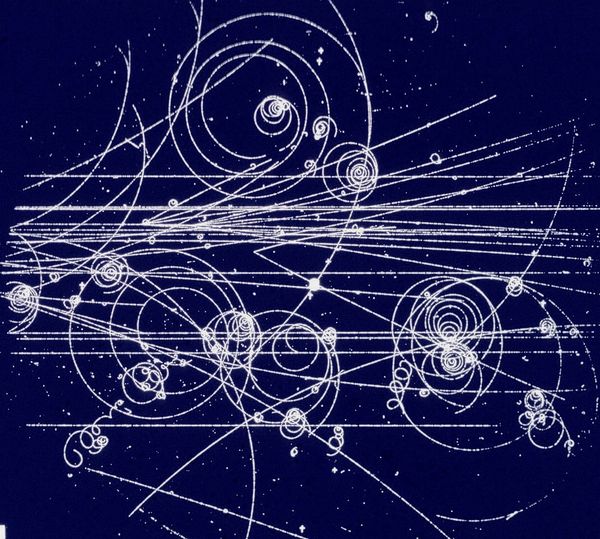
The Universe began with energy that became photons and particles E=mc2 also means E/c2 = m
(This image is also useful in checking your eyes for astigmatism, and to see if your eye glasses are correct.)
Hmmm ... there seem to be a few things missing here.
- If galaxies appear 13 billion ly away, but their light left the redshifting galaxies 13 billion years ago ... how big is the Universe now?
- When something appears to recede with a redshift of z = 1000, does time change ?
- Dark energy seems to be making the Universe inflate faster and faster, while dark matter seems to be holding it together, but we don't know what either one is.
- Did time exist before the Big Bang?
- If gravity around massive objects alters space and time, what happens around a black hole?